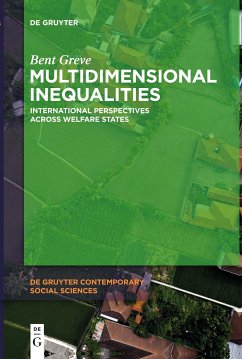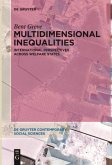12,99 €
inkl. MwSt.
Versandfertig in 6-10 Tagen

6 °P sammeln
- Broschiertes Buch
- Merkliste
- Auf die Merkliste
- Bewerten Bewerten
- Teilen
- Produkt teilen
- Produkterinnerung
- Produkterinnerung
Multidimensional Inequalities is a deep dive into the historical contexts and contemporary realities that negatively influence society and its structures. It is often overlooked that inequality is not just about income and wealth but rather a broad spectrum of intersecting factors. This book focuses on each aspect individually, analysing its effect on welfare systems, and informs about the instruments available to reduce inequality.
Andere Kunden interessierten sich auch für
![Multidimensional Inequalities Multidimensional Inequalities]() Bent GreveMultidimensional Inequalities94,95 €
Bent GreveMultidimensional Inequalities94,95 €![Die Neuerfindung des Sozialen Die Neuerfindung des Sozialen]() Stephan LessenichDie Neuerfindung des Sozialen18,80 €
Stephan LessenichDie Neuerfindung des Sozialen18,80 €![Armutsdiskurse Armutsdiskurse]() Armutsdiskurse35,00 €
Armutsdiskurse35,00 €![The Independent Variable Problem The Independent Variable Problem]() Katharina KunißenThe Independent Variable Problem31,99 €
Katharina KunißenThe Independent Variable Problem31,99 €![Die zerrissene Republik Die zerrissene Republik]() Christoph ButterweggeDie zerrissene Republik24,95 €
Christoph ButterweggeDie zerrissene Republik24,95 €![Leben im Ruhestand Leben im Ruhestand]() Leben im Ruhestand29,99 €
Leben im Ruhestand29,99 €![(Post)transformational Migration (Post)transformational Migration]() (Post)transformational Migration64,80 €
(Post)transformational Migration64,80 €-
-
-
Multidimensional Inequalities is a deep dive into the historical contexts and contemporary realities that negatively influence society and its structures. It is often overlooked that inequality is not just about income and wealth but rather a broad spectrum of intersecting factors. This book focuses on each aspect individually, analysing its effect on welfare systems, and informs about the instruments available to reduce inequality.
Produktdetails
- Produktdetails
- De Gruyter Contemporary Social Sciences 4
- Verlag: De Gruyter
- 1. Auflage
- Seitenzahl: 180
- Erscheinungstermin: 17. Juni 2024
- Englisch
- Abmessung: 230mm x 155mm x 11mm
- Gewicht: 428g
- ISBN-13: 9783110720181
- ISBN-10: 3110720183
- Artikelnr.: 70422708
- Herstellerkennzeichnung Die Herstellerinformationen sind derzeit nicht verfügbar.
- De Gruyter Contemporary Social Sciences 4
- Verlag: De Gruyter
- 1. Auflage
- Seitenzahl: 180
- Erscheinungstermin: 17. Juni 2024
- Englisch
- Abmessung: 230mm x 155mm x 11mm
- Gewicht: 428g
- ISBN-13: 9783110720181
- ISBN-10: 3110720183
- Artikelnr.: 70422708
- Herstellerkennzeichnung Die Herstellerinformationen sind derzeit nicht verfügbar.
Bent Greve is Professor in Social Science with an emphasis on welfare state analysis at the University of Roskilde, Denmark. His research interest focuses on the welfare state, and social and labour market policy, often from a comparative perspective. He has published extensively on social and labour market policy, social security, tax expenditures, public sector expenditures and financing of the welfare state. He is editor of Social Policy & Administration. Recent books include Long-Term Care for the Elderly in Europe. Development and Prospects (Ed.) (Routledge), Handbook of Social Policy Evaluation (ed.) (Edward Elgar), Technology and the Future of Work.The Impact on Labour Markets and Welfare States (Edward Elgar), The Routledge Handbook of the Welfare State, 2nd edition (Routledge), Welfare, populism and welfare chauvinism (Bristol University Press), Austerity, Retrenchment and the Welfare State (Edward Elgar), Routledge International Handbook of the Welfare State.
Preliminary structure of the book
(a short overview of the expected chapters)
This last chapter summarizes the analysis and production of inequality while focusing on both national and international opportunities to reduce inequality, including poverty. It is also proposed to include a broader perspective on the development of welfare states.
(a short overview of the expected chapters)
- Introduction
- Theoretical understanding and measurement of equality/inequality - a number of issues - and not only in relation to money
- Equalities in opportunities - Sen's perspective on justice and inequality
- Economic inequality
- Gender inequality
- Inequality in health care
- Inequality in educational attainment
- Inequalities in employment and unemployment
- Ethnic inequality
- Democratic inequality
- Contribute the welfare state to increase in inequality?
- What instruments are available to create a higher degree of inequality?
- National and international possibilities
If one wants to discuss inequality, it is not only necessary to have normative justice considerations, where, moreover, there is often a greater consensus on when something is unjust than when a situation is equal. An overview will be given of key theoretical aspects in relation to understanding justice and inequality, as well as elements to be taken into account when inequality is to be assessed, including, for example, time horizons for measuring the degree of inequality. We will also discuss what type of inequality is being measured (for example, inequality in opportunity or resources, or whether it is inequality in measured welfare / resources. Finally, the chapter will present the most central ways inequality is measured while discussing why these are usable and why not other measurements tools that can be more precise are used in the analysis in the book. Core concepts will be defined.
The chapter will also look into the issue of trickle-down economy, e.g. that if the rich becomes richer this is also the case for the poor.
Causes and explanations for inequality, for example, look at differences in the opportunities each individual has. Thus, the focus is on whether everyone basically has the same opportunities to achieve a number of things in life, including the ability to choose among a set of functioning's. This chapter will, based on Sen's concept of capabilities, focus on whether and, if so, how such an understanding can help explain inequality. It also raises the debate that if two people have the same opportunities but use their opportunities differently and there will be ex-ante inequality then there is a societal problem.
Central for analysis has in many years been the economic inequality between individuals and households, as well as over time. Inequality in income and wealth has been central, including not only the distribution measured more overall, but also, for example, the proportion of total income the 1% of the population are earning. The chapter provides a historical outline of developments in inequality, as well as a more detailed comparison of developments in a selection of European welfare states representing different regimes. This analysis will, to a limited extent, also include explanations, cf. chapters 10 and 11 instead.
There has been, for some time now, a focus on gender equality, and it has been seen as more developed in the Nordic welfare states than in other types of welfare states. The chapter will present a number of indicators of inequality, but also the trends therein, as well as areas where the different gender have a better / worse position in society. This is probably illustrated by the fact that there has been a development towards greater equality, but at the same time that there are inequalities in a number of areas, for example in relation to pay and living in poverty, as well as in life-expectancy.
Where economic inequality is often to the disadvantage of women, the picture is different when looking at health inequality. The chapter describes through a selection of indicators the degree of health inequality in a number of welfare states. Although there are universal health systems in welfare states, there is a great difference between how long people live, what diseases they get and whether they have an experience of good health and could pay for medicine, for example. This also includes people's own perception of whether they have a good health and differences in life-expectancy.
The level of education is of great importance for a wide range of inequalities, which are highlighted in a number of the other chapters of the book. This chapter attempts to shed light on causes of education inequality. Here, not only must we look at basic education, but also at participation in continuing education, which, given the expected technological development, must be assumed to be increasingly important. A comparative overview of differences between countries in education inequality is also provided.
Labour markets are divided nationally as well as internationally. There are differences between who is part of the workforce and who is not, and there are differences in the risk of being unemployed. This includes variations between young and elderly, between different degrees of ethnicity. Different groups also have varying probabilities of becoming long-term unemployed. In addition, they differ in earnings in different parts of the labour market. The situation and possible causes for the development (globalization, new technology, etc.) will be included in the presentation.
An ongoing discussion in recent years, partly also due to the issue of populism, has been the difference between native and non-natives position in societies. This chapter will show differences in a number of areas as indicator of that this is and has been a dimension one need to be aware of if one want's to understand and explain the varieties in the level of inequality across countries.
The focus in this chapter is on who have the opportunity to make decisions about key societal issues and whether or not there is equal access to participate in societal decision-making. This is also linked to the populist discussion, which can be argued to be a type of explanation for why there are some who believe that there is an elite that decides and solely accepts their own ideas and interests.
Welfare states have been seen as a piggy-bank (Barr 2001), which allows the individual citizen to be protected against a number of social risks. This contributes to a greater degree of equality, as the individual does not have to secure against a number of social events. Thus, there is a discussion that welfare states can contribute to redistribution over a life course and between rich and poor. This redistribution can be achieved through the layout of the tax system, but also through the provision of a number of public services. These types of arguments are presented together with an analysis of whether and the degree of redistribution in various welfare states, including as far as possible development over time.
The chapter will also look into the question whether everyone has the same opportunity to have consumption opportunities in a community. This obviously has a clear connection between the income and wealth of the individual person / household when looking at private consumption. But in addition, depending on the type of welfare state, there may be differences in access to public consumption, which may thus compensate for differences in access to private consumption.
Finally, given the need for a welfare state also in relation to ensuring equality in access to, redistribution between rich and poor and over the life-time why do we still see such a large degree of differences among welfare states, and why no convergence seemingly is under way.
Chapter 10 looked at whether welfare states contribute to a greater degree of equality. This chapter is followed up with a number of fundamental considerations and presentations of what instrument welfare states have if they wish to reduce inequality, including the advantages and disadvantages of choosing between different types of instruments. We look at how welfare states can be financed, as well as income transfers and public service activities.
This last chapter summarizes the analysis and production of inequality while focusing on both national and international opportunities to reduce inequality, including poverty. It is also proposed to include a broader perspective on the development of welfare states.
Preliminary structure of the book
(a short overview of the expected chapters)
This last chapter summarizes the analysis and production of inequality while focusing on both national and international opportunities to reduce inequality, including poverty. It is also proposed to include a broader perspective on the development of welfare states.
(a short overview of the expected chapters)
- Introduction
- Theoretical understanding and measurement of equality/inequality - a number of issues - and not only in relation to money
- Equalities in opportunities - Sen's perspective on justice and inequality
- Economic inequality
- Gender inequality
- Inequality in health care
- Inequality in educational attainment
- Inequalities in employment and unemployment
- Ethnic inequality
- Democratic inequality
- Contribute the welfare state to increase in inequality?
- What instruments are available to create a higher degree of inequality?
- National and international possibilities
If one wants to discuss inequality, it is not only necessary to have normative justice considerations, where, moreover, there is often a greater consensus on when something is unjust than when a situation is equal. An overview will be given of key theoretical aspects in relation to understanding justice and inequality, as well as elements to be taken into account when inequality is to be assessed, including, for example, time horizons for measuring the degree of inequality. We will also discuss what type of inequality is being measured (for example, inequality in opportunity or resources, or whether it is inequality in measured welfare / resources. Finally, the chapter will present the most central ways inequality is measured while discussing why these are usable and why not other measurements tools that can be more precise are used in the analysis in the book. Core concepts will be defined.
The chapter will also look into the issue of trickle-down economy, e.g. that if the rich becomes richer this is also the case for the poor.
Causes and explanations for inequality, for example, look at differences in the opportunities each individual has. Thus, the focus is on whether everyone basically has the same opportunities to achieve a number of things in life, including the ability to choose among a set of functioning's. This chapter will, based on Sen's concept of capabilities, focus on whether and, if so, how such an understanding can help explain inequality. It also raises the debate that if two people have the same opportunities but use their opportunities differently and there will be ex-ante inequality then there is a societal problem.
Central for analysis has in many years been the economic inequality between individuals and households, as well as over time. Inequality in income and wealth has been central, including not only the distribution measured more overall, but also, for example, the proportion of total income the 1% of the population are earning. The chapter provides a historical outline of developments in inequality, as well as a more detailed comparison of developments in a selection of European welfare states representing different regimes. This analysis will, to a limited extent, also include explanations, cf. chapters 10 and 11 instead.
There has been, for some time now, a focus on gender equality, and it has been seen as more developed in the Nordic welfare states than in other types of welfare states. The chapter will present a number of indicators of inequality, but also the trends therein, as well as areas where the different gender have a better / worse position in society. This is probably illustrated by the fact that there has been a development towards greater equality, but at the same time that there are inequalities in a number of areas, for example in relation to pay and living in poverty, as well as in life-expectancy.
Where economic inequality is often to the disadvantage of women, the picture is different when looking at health inequality. The chapter describes through a selection of indicators the degree of health inequality in a number of welfare states. Although there are universal health systems in welfare states, there is a great difference between how long people live, what diseases they get and whether they have an experience of good health and could pay for medicine, for example. This also includes people's own perception of whether they have a good health and differences in life-expectancy.
The level of education is of great importance for a wide range of inequalities, which are highlighted in a number of the other chapters of the book. This chapter attempts to shed light on causes of education inequality. Here, not only must we look at basic education, but also at participation in continuing education, which, given the expected technological development, must be assumed to be increasingly important. A comparative overview of differences between countries in education inequality is also provided.
Labour markets are divided nationally as well as internationally. There are differences between who is part of the workforce and who is not, and there are differences in the risk of being unemployed. This includes variations between young and elderly, between different degrees of ethnicity. Different groups also have varying probabilities of becoming long-term unemployed. In addition, they differ in earnings in different parts of the labour market. The situation and possible causes for the development (globalization, new technology, etc.) will be included in the presentation.
An ongoing discussion in recent years, partly also due to the issue of populism, has been the difference between native and non-natives position in societies. This chapter will show differences in a number of areas as indicator of that this is and has been a dimension one need to be aware of if one want's to understand and explain the varieties in the level of inequality across countries.
The focus in this chapter is on who have the opportunity to make decisions about key societal issues and whether or not there is equal access to participate in societal decision-making. This is also linked to the populist discussion, which can be argued to be a type of explanation for why there are some who believe that there is an elite that decides and solely accepts their own ideas and interests.
Welfare states have been seen as a piggy-bank (Barr 2001), which allows the individual citizen to be protected against a number of social risks. This contributes to a greater degree of equality, as the individual does not have to secure against a number of social events. Thus, there is a discussion that welfare states can contribute to redistribution over a life course and between rich and poor. This redistribution can be achieved through the layout of the tax system, but also through the provision of a number of public services. These types of arguments are presented together with an analysis of whether and the degree of redistribution in various welfare states, including as far as possible development over time.
The chapter will also look into the question whether everyone has the same opportunity to have consumption opportunities in a community. This obviously has a clear connection between the income and wealth of the individual person / household when looking at private consumption. But in addition, depending on the type of welfare state, there may be differences in access to public consumption, which may thus compensate for differences in access to private consumption.
Finally, given the need for a welfare state also in relation to ensuring equality in access to, redistribution between rich and poor and over the life-time why do we still see such a large degree of differences among welfare states, and why no convergence seemingly is under way.
Chapter 10 looked at whether welfare states contribute to a greater degree of equality. This chapter is followed up with a number of fundamental considerations and presentations of what instrument welfare states have if they wish to reduce inequality, including the advantages and disadvantages of choosing between different types of instruments. We look at how welfare states can be financed, as well as income transfers and public service activities.
This last chapter summarizes the analysis and production of inequality while focusing on both national and international opportunities to reduce inequality, including poverty. It is also proposed to include a broader perspective on the development of welfare states.







